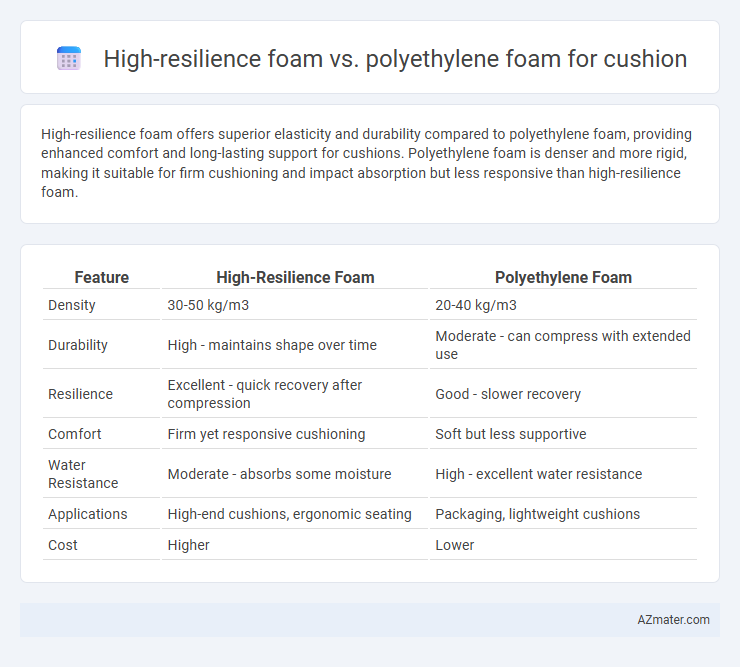High-resilience foam offers superior elasticity and durability compared to polyethylene foam, providing enhanced comfort and long-lasting support for cushions. Polyethylene foam is denser and more rigid, making it suitable for firm cushioning and impact absorption but less responsive than high-resilience foam.
Table of Comparison
| Feature | High-Resilience Foam | Polyethylene Foam |
|---|---|---|
| Density | 30-50 kg/m3 | 20-40 kg/m3 |
| Durability | High - maintains shape over time | Moderate - can compress with extended use |
| Resilience | Excellent - quick recovery after compression | Good - slower recovery |
| Comfort | Firm yet responsive cushioning | Soft but less supportive |
| Water Resistance | Moderate - absorbs some moisture | High - excellent water resistance |
| Applications | High-end cushions, ergonomic seating | Packaging, lightweight cushions |
| Cost | Higher | Lower |
Introduction to Cushioning Foams
High-resilience foam offers superior durability and excellent energy return, making it ideal for cushioning applications requiring long-term comfort and support. Polyethylene foam provides lightweight, closed-cell properties with good impact absorption and moisture resistance, suited for protective packaging and less intensive cushioning needs. Understanding the density, cell structure, and resilience of these foams helps determine their optimal use in different cushioning products.
Understanding High-Resilience Foam
High-resilience foam offers superior durability and support due to its open-cell structure, which enhances breathability and comfort in cushions. Its high elasticity allows it to quickly regain shape, making it ideal for prolonged seating without sagging or deformation. Compared to polyethylene foam, high-resilience foam provides better cushioning performance and longevity, especially in applications requiring consistent firmness and pressure distribution.
Key Properties of Polyethylene Foam
Polyethylene foam offers excellent durability, high resistance to moisture, and good insulation properties, making it ideal for cushioning applications requiring long-term performance. Its closed-cell structure provides superior impact absorption and prevents water absorption, enhancing protection against shocks and vibrations. This foam's lightweight nature and chemical resistance add to its versatility in packaging and cushioning solutions compared to high-resilience foam.
Comfort and Support Comparison
High-resilience foam offers superior comfort and support with its excellent elasticity and durability, making it ideal for cushions requiring long-lasting resilience and pressure distribution. Polyethylene foam provides firm support but tends to have a lower rebound rate, resulting in less cushioning and potential discomfort over extended use. For applications prioritizing prolonged comfort and adaptive support, high-resilience foam is generally the better choice compared to polyethylene foam.
Durability and Longevity Analysis
High-resilience foam offers superior durability due to its open-cell structure that maintains shape and firmness over extended periods, making it ideal for cushions requiring long-term support. Polyethylene foam, while lightweight and water-resistant, tends to compress and degrade faster under continuous use, reducing its longevity in high-traffic seating applications. Analyzing resilience and density metrics, high-resilience foam typically outperforms polyethylene foam in retaining cushioning performance and structural integrity over time.
Application Suitability for Cushions
High-resilience foam offers superior elasticity and durability, making it ideal for cushions that require long-lasting support and comfort, such as sofa cushions and mattress toppers. Polyethylene foam, with its lightweight and moisture-resistant properties, is better suited for outdoor cushions and seating pads where water resistance and gradual compression are essential. Choosing between the two depends on the specific application needs, balancing endurance, firmness, and environmental exposure.
Moisture and Allergen Resistance
High-resilience foam offers superior moisture resistance due to its open-cell structure, allowing better ventilation and quicker drying, which helps prevent mold and mildew growth. Polyethylene foam, being closed-cell, resists moisture penetration more effectively, creating a barrier that inhibits water absorption and allergen accumulation. Both foams provide allergen resistance, but polyethylene foam is often preferred in environments requiring enhanced protection against dust mites and bacteria due to its dense, impermeable nature.
Cost-Effectiveness Overview
High-resilience foam offers superior durability and support, making it cost-effective for long-term cushioning despite a higher initial price compared to polyethylene foam. Polyethylene foam provides an affordable cushioning solution with moderate durability, suitable for low-traffic or temporary applications where budget constraints are critical. Evaluating the total lifecycle cost and intended use helps determine whether the investment in high-resilience foam delivers better overall value than the lower-cost polyethylene alternative.
Environmental Impact and Recyclability
High-resilience foam offers superior durability and typically contains fewer chemicals, which can reduce environmental impact compared to polyethylene foam that often involves petrochemical-derived components. Polyethylene foam is more widely recycled due to established industrial processes, whereas high-resilience foam recycling remains limited and less efficient. Choosing foam types depends on balancing long-term environmental sustainability with available recycling infrastructure for each material.
Choosing the Right Foam for Your Cushion Needs
High-resilience foam offers superior durability, excellent support, and long-lasting comfort, making it ideal for cushions requiring firm yet flexible seating. Polyethylene foam provides excellent shock absorption and water resistance, suitable for outdoor cushions or applications needing lightweight, moisture-resistant materials. Choosing the right foam depends on your specific needs: select high-resilience foam for high-traffic indoor cushions and polyethylene foam for moisture-prone or portable cushioning solutions.

Infographic: High-resilience foam vs Polyethylene foam for Cushion
 azmater.com
azmater.com